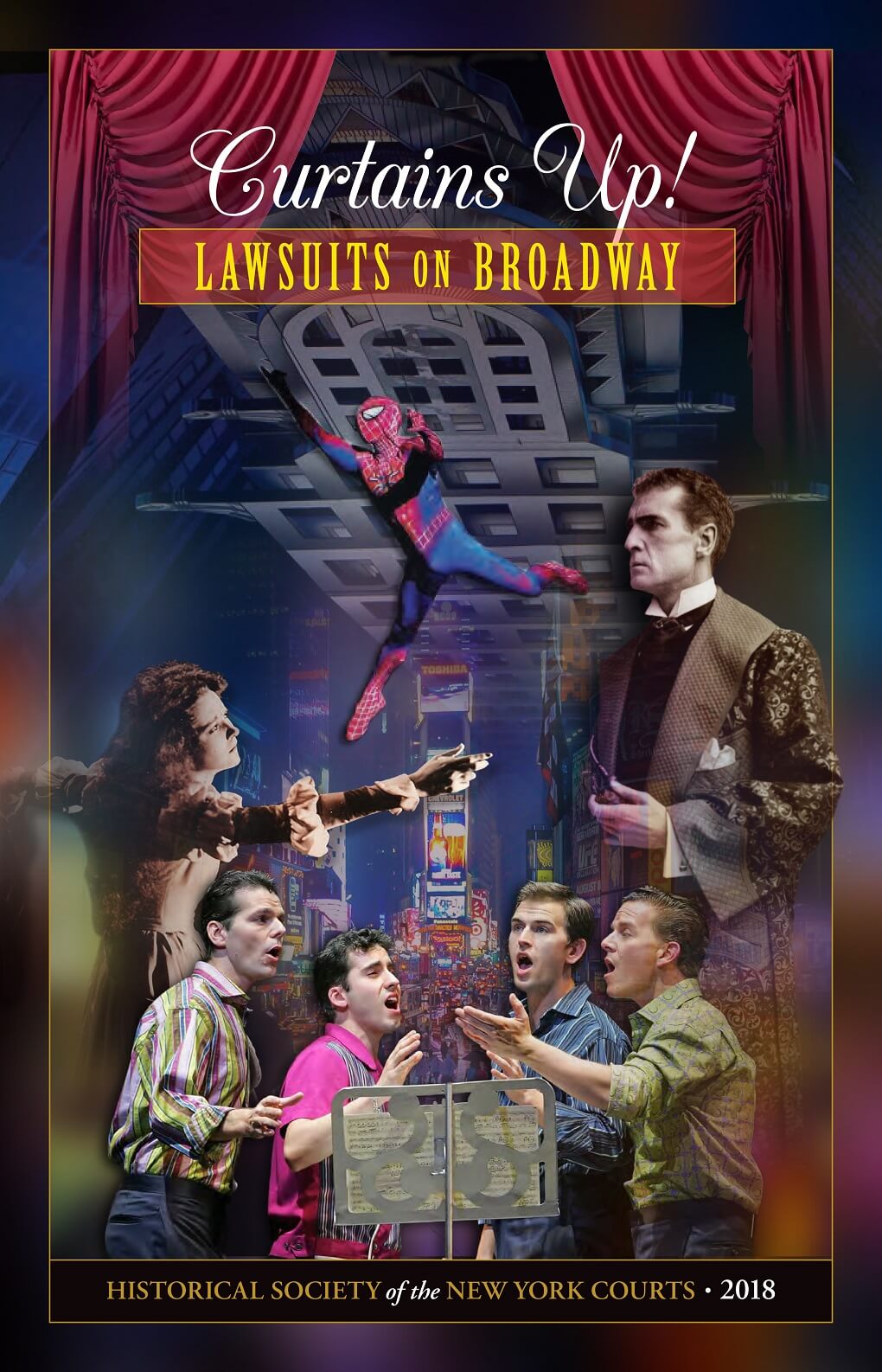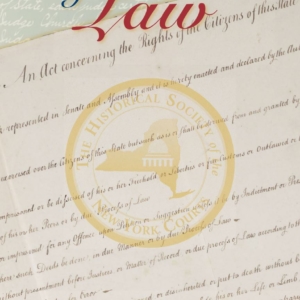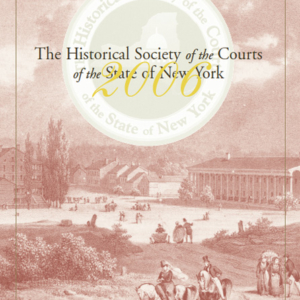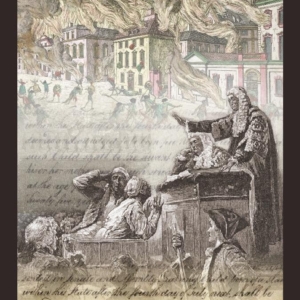Description
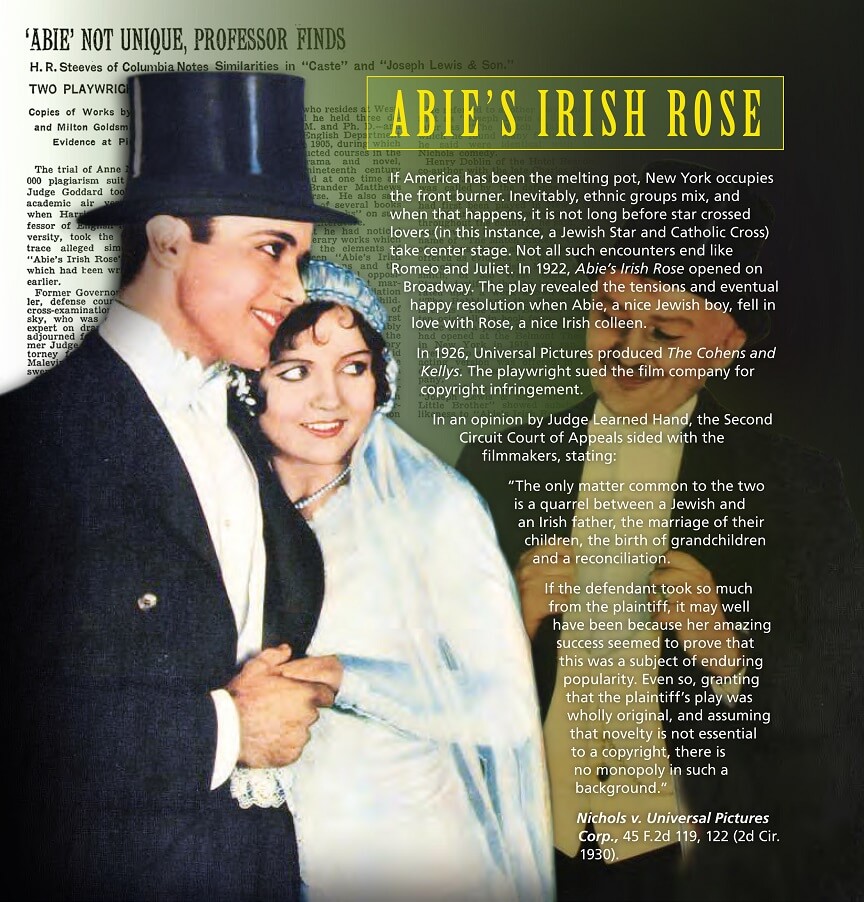
Abie’s Irish Rose
If America has been the melting pot, New York occupies the front burner. Inevitably, ethnic groups mix, and when that happens, it is not long before star crossed lovers (in this instance, a Jewish Star and Catholic Cross) take center stage. Not all such encounters end like Romeo and Juliet. In 1922, Abie’s Irish Rose opened on Broadway. The play revealed the tensions and eventual happy resolution when Abie, a nice Jewish boy, fell in love with Rose, a nice Irish colleen.
In 1926, Universal Pictures produced The Cohens and Kellys. The playwright sued the film company for copyright infringement.
In an opinion by Judge Learned Hand, the Second Circuit Court of Appeals sided with the filmmakers, stating:
The only matter common to the two is a quarrel between a Jewish and an Irish father, the marriage of their children, the birth of grandchildren and a reconciliation.
If the defendant took so much from the plaintiff, it may well have been because her amazing success seemed to prove that this was a subject of enduring popularity. Even so, granting that the plaintiff’s play was wholly original, and assuming that novelty is not essential to a copyright, there is no monopoly in such a background.
Nichols v. Universal Pictures Corp., 45 F.2d 119, 122 (2d Cir. 1930).
Images:
The New York Times, January 5, 1929. Copyright The New York Times
Theatrical release poster for Abie’s Irish Rose, a 1928 Paramount Pictures film. Promotional image by Paramount Pictures
Lobby card for Abie’s Irish Rose (1928), featuring actors Charles “Buddy” Rogers and Nancy Carroll. Promotional image by Paramount Pictures
February 2018
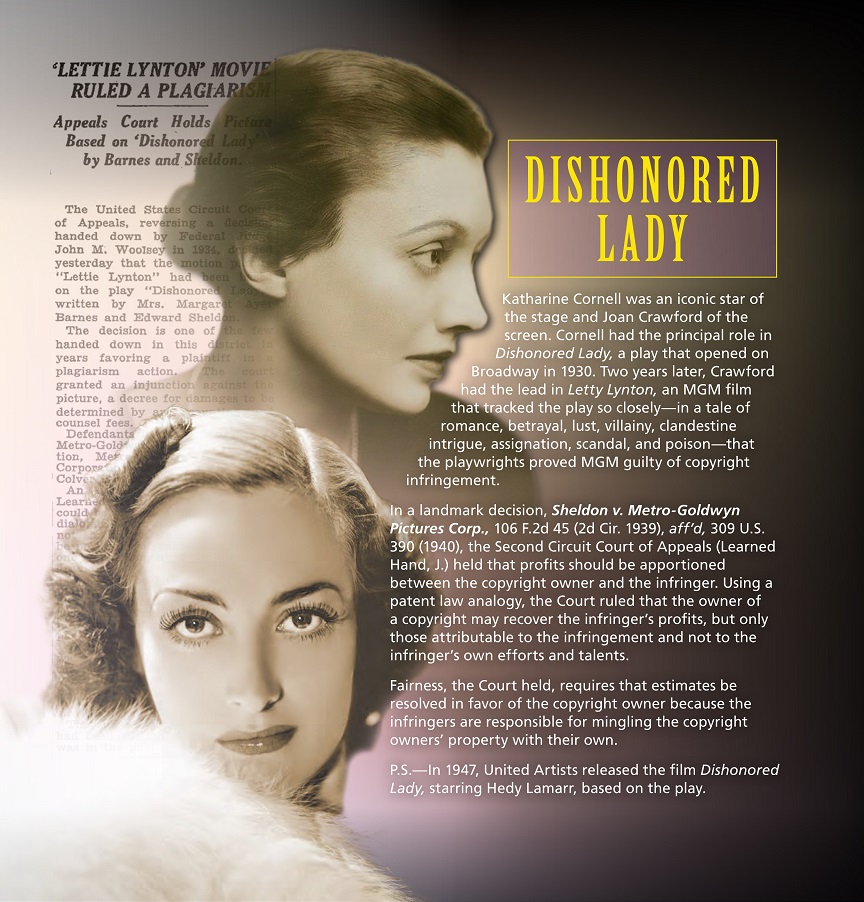
Dishonored Lady
Katharine Cornell was an iconic star of the stage and Joan Crawford of the screen. Cornell had the principal role in Dishonored Lady, a play that opened on Broadway in 1930. Two years later, Crawford had the lead in Letty Lynton, an MGM film that tracked the play so closely—in a tale of romance, betrayal, lust, villainy, clandestine intrigue, assignation, scandal, and poison—that the playwrights proved MGM guilty of copyright infringement.
In a landmark decision, Sheldon v. Metro-Goldwyn Pictures Corp., 106 F.2d 45 (2d Cir. 1939), aff’d, 309 U.S. 390 (1940), the Second Circuit Court of Appeals (Learned Hand, J.) held that profits should be apportioned between the copyright owner and the infringer. Using a patent law analogy, the Court ruled that the owner of a copyright may recover the infringer’s profits, but only those attributable to the infringement and not to the infringer’s own efforts and talents.
Fairness, the Court held, requires that estimates be resolved in favor of the copyright owner because the infringers are responsible for mingling the copyright owners’ property with their own.
P.S.—In 1947, United Artists released the film Dishonored Lady, starring Hedy Lamarr, based on the play.
Images:
Katharine Cornell, star of the stage production of Dishonored Lady, in a publicity photograph. Photograph by Vandamm Studio
Joan Crawford, star of Letty Lynton, in a 1930s publicity photograph. Promotional image by Metro-Goldwyn-Mayer
The New York Times, January 18, 1936. Copyright The New York Times
March 2018
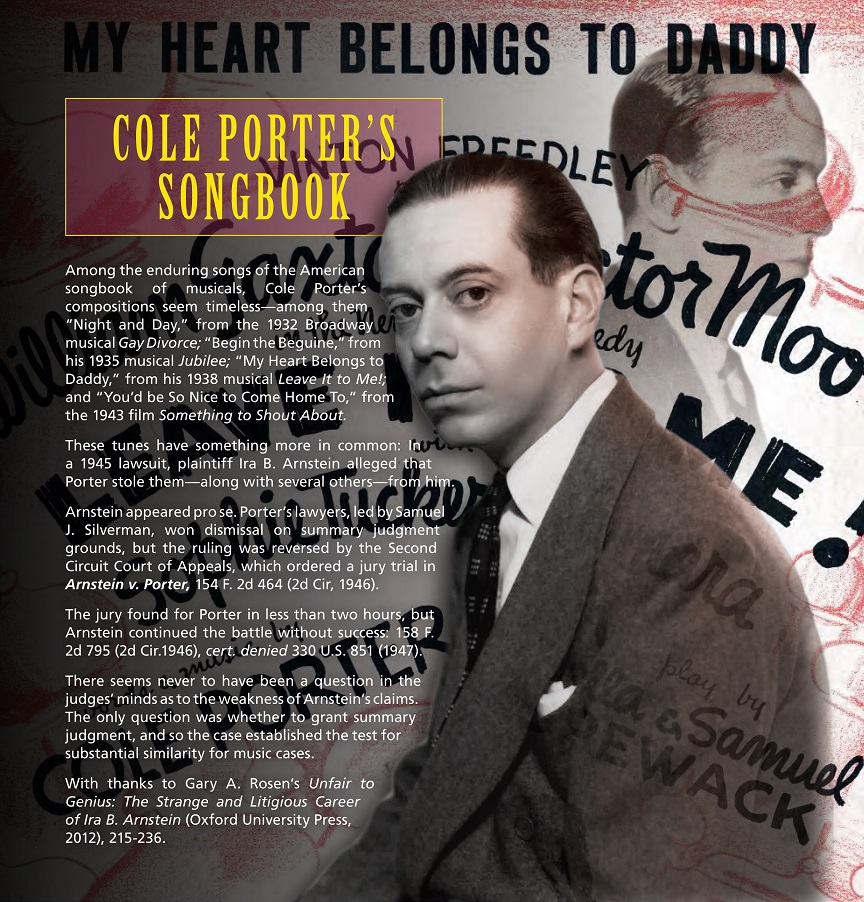
Cole Porter’s Soundbook
Among the enduring songs of the American songbook of musicals, Cole Porter’s compositions seem timeless—among them “Night and Day,” from the 1932 Broadway musical Gay Divorce; “Begin the Beguine,” from his 1935 musical Jubilee; “My Heart Belongs to Daddy,” from his 1938 musical Leave It to Me!; and “You’d be So Nice to Come Home To,” from the 1943 film Something to Shout About.
These tunes have something more in common: In a 1945 lawsuit, plaintiff Ira B. Arnstein alleged that Porter stole them—along with several others—from him.
Arnstein appeared pro se. Porter’s lawyers, led by Samuel J. Silverman, won dismissal on summary judgment grounds, but the ruling was reversed by the Second Circuit Court of Appeals, which ordered a jury trial in Arnstein v. Porter, 154 F. 2d 464 (2d Cir, 1946).
The jury found for Porter in less than two hours, but Arnstein continued the battle without success: 158 F. 2d 795 (2d Cir.1946), cert. denied 330 U.S. 851 (1947).
There seems never to have been a question in the judges’ minds as to the weakness of Arnstein’s claims. The only question was whether to grant summary judgment, and so the case established the test for substantial similarity for music cases.
With thanks to Gary A. Rosen’s Unfair to Genius: The Strange and Litigious Career of Ira B. Arnstein (Oxford University Press, 2012), 215-236.
Images:
Portrait of composer Cole Porter, circa 1930s. Courtesy of The Old Globe
Program for Gay Divorce, featuring actor Fred Astaire. New York Theatre Program Corporation, 1933
Program for Leave It to Me! (1938). Chappell & Co. Inc.
April 2018

Shakespeare in the Park
After two seasons at the East River Park Amphitheater, Joseph Papp’s Shakespeare in the Park moved to Central Park. The Delacorte Theater became its permanent home, but not before a legal battle. New York City Parks Commissioner Robert Moses demanded that Papp and his company charge a fee for the performances.
In Shakespeare Workshop v. Moses 8 A.D. 2d 343 (1st Dept. 1959), the Court disagreed:
“In respect of park permits, it is clear [the Commissioner] has a wide discretion. This discretion, however, is not unbounded. Its exercise must be related to and consistent with park purposes. Parks are primarily for the use, benefit and enjoyment of the public. The maintenance and use of parks do not empower regulation of the internal financial policies of an applicant so long as adequate and reasonable provision is made for reimbursement of the expense resulting from his use…
Where, as here, it is apparent that the sole substantial ground for the denial of the permit is arbitrary, capricious and unreasonable, the determination should and must be vacated and set aside.”
Let the curtain rise.
Images:
Frontispiece and title page of William Shakespeare’s First Folio. By permission of the Folger Shakespeare Library
Poster advertising a production of Romeo & Juliet, c. 1879. Library of Congress, Prints & Photographs Division, LC-USZ62-132746
May 2018
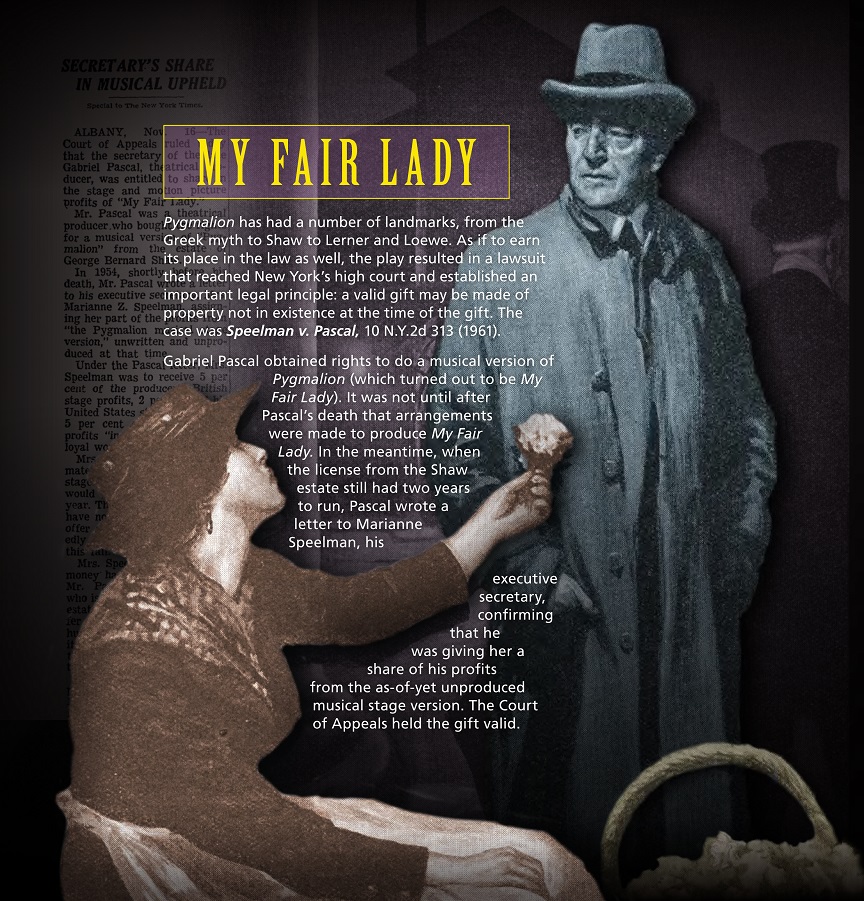
My Fair Lady
Pygmalion has had a number of landmarks, from the Greek myth to Shaw to Lerner and Loewe. As if to earn its place in the law as well, the play resulted in a lawsuit that reached New York’s high court and established an important legal principle: a valid gift may be made of property not in existence at the time of the gift. The case was Speelman v. Pascal, 10 N.Y.2d 313 (1961).
Gabriel Pascal obtained rights to do a musical version of Pygmalion (which turned out to be My Fair Lady). It was not until after Pascal’s death that arrangements were made to produce My Fair Lady. In the meantime, when the license from the Shaw estate still had two years to run, Pascal wrote a letter to Marianne Speelman, his executive secretary, confirming that he was giving her a share of his profits from the as-of-yet unproduced musical stage version. The Court of Appeals held the gift valid.
Images:
The New York Times, November 17, 1961. Copyright The New York Times
Illustration from Shaw’s Pygmalion by artist Vapilley, 1914. Brown Digital Repository, Brown University Library, Identifier: AP2.N37
June 2018

Baker Street
Ever since “A Study in Scarlet” in Beeton’s Christmas Annual in 1887, Sherlock Holmes has appeared in drama, parody, satire, film, poetry, literary criticism, and even dance. In 1965, Sir Arthur Conan Doyle’s Great Detective, aided by composer Jerry Bock and lyricist Sheldon Harnick (of Fiddler on the Roof fame), appeared in a Broadway musical named after the fabled street on which Holmes and Dr. Watson lived.
Holmes has appeared in the New York law reports as well, most notably not long after the start of his film career, in Gillette v. Stoll Film Co., 120 Misc. 850 (N.Y. Sup. Ct. 1922), aff’d 206 A.D. 617 (1st Dept. 1923), in which the Court denied a preliminary injunction based on a propriety claim seeking to enjoin a series of Holmes films.
Holmes is in the public domain even if a handful of the later stories are still under copyright.
Images:
The New York Times, February 17, 1965. Copyright The New York Times
View of Baker Street by Joseph Pennell, 1908. Library of Congress, Prints & Photographs Division, LC-DIG-ppmsca-38044
William Gillette as Sherlock Holmes, c. 1900s. Courtesy of The Sherlock Holmes Society of London
July 2018
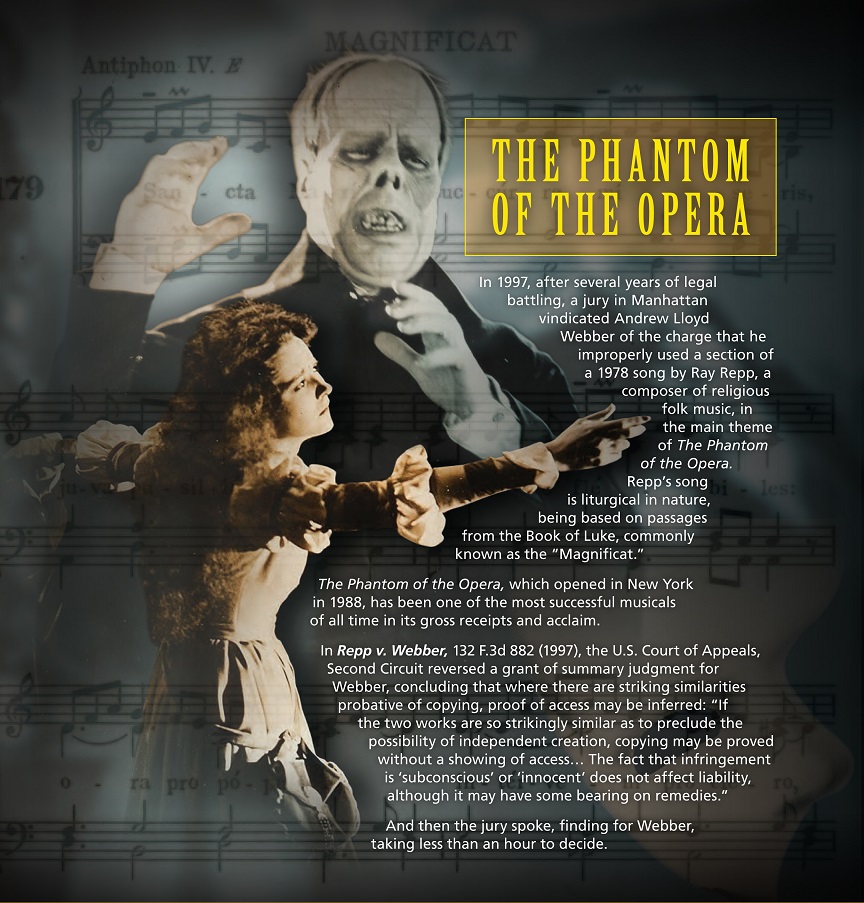
The Phantom of the Opera
In 1997, after several years of legal battling, a jury in Manhattan vindicated Andrew Lloyd Webber of the charge that he improperly used a section of a 1978 song by Ray Repp, a composer of religious folk music, in the main theme of The Phantom of the Opera.
Repp’s song is liturgical in nature, being based on passages from the Book of Luke, commonly known as the “Magnificat.”
The Phantom of the Opera, which opened in New York in 1988, has been one of the most successful musicals of all time in its gross receipts and acclaim.
In Repp v. Webber, 132 F.3d 882 (1997), the U.S. Court of Appeals, Second Circuit reversed a grant of summary judgment for Webber, concluding that where there are striking similarities probative of copying, proof of access may be inferred: “If the two works are so strikingly similar as to preclude the possibility of independent creation, copying may be proved without a showing of access… The fact that infringement is ‘subconscious’ or ‘innocent’ does not affect liability, although it may have some bearing on remedies.”
And then the jury spoke, finding for Webber, taking less than an hour to decide.
Images:
Sheet music from the “Magnifcat.” Published in The De Le Salle Hymnal: For Catholic Schools and Choirs, eds. Christian Brothers (1913)
Actor Lon Chaney in a film production of The Phantom of the Opera, directed by Rupert Julian, 1925. Courtesy of The Red List
Actors Lon Chaney and Mary Philbin in a film production of The Phantom of the Opera, directed by Robert Julian, 1925. Courtesy of The Red List
August 2018
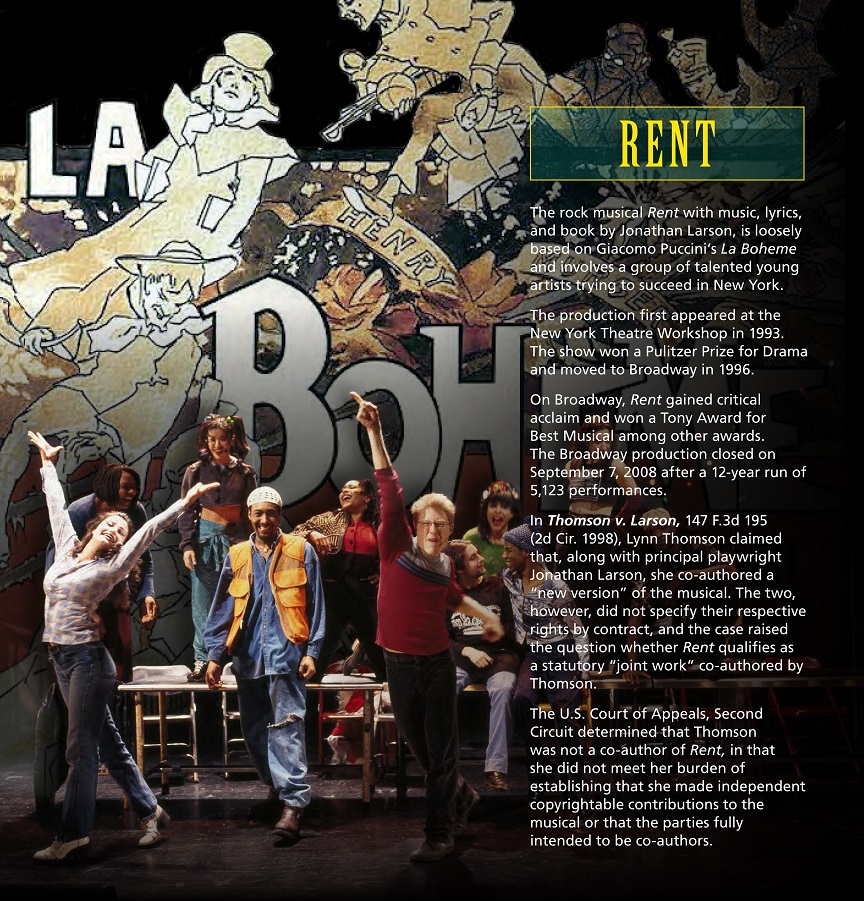
Rent
The rock musical Rent with music, lyrics, and book by Jonathan Larson, is loosely based on Giacomo Puccini’s La Boheme and involves a group of talented young artists trying to succeed in New York.
The production first appeared at the New York Theatre Workshop in 1993. The show won a Pulitzer Prize for Drama and moved to Broadway in 1996.
On Broadway, Rent gained critical acclaim and won a Tony Award for Best Musical among other awards. The Broadway production closed on September 7, 2008 after a 12-year run of 5,123 performances.
In Thomson v. Larson, 147 F.3d 195 (2d Cir. 1998), Lynn Thomson claimed that, along with principal playwright Jonathan Larson, she co-authored a “new version” of the musical. The two, however, did not specify their respective rights by contract, and the case raised the question whether Rent qualifies as a statutory “joint work” co-authored by Thomson.
The U.S. Court of Appeals, Second Circuit determined that Thomson was not a co-author of Rent, in that she did not meet her burden of establishing that she made independent copyrightable contributions to the musical or that the parties fully intended to be co-authors.
Images:
The cast of Rent at New York Theater Workshop, 1996, photographed by Sara Krulwich for the New York Times. Copyright Sara Krulwich/The New York Times
Poster for Giacomo Puccini’s opera La bohème with artwork by Aldofo Hohenstein 1896. Courtesy of Wikimedia Commons
September 2018

Spider-Man
In 1962, Stan Lee developed the idea for a “nerdy” teenage hero with the power to stick to walls and ceilings like an insect. Spider-Man first appeared in Amazing Fantasy in September 1962. He was so popular that publisher Martin Goodman gave the character its own comic book. The Amazing Spider-Man was first published in March 1963.
The Broadway production, Spider-Man: Turn Off the Dark, which opened in 2011, was often in the headlines, not least because of a complex web of lawsuits (pardon the pun) between director Julie Taymor and the show’s producer, 8 Legged Productions. Taymor had been relieved of her duties in late 2012 following negative reviews and an extensive re-write; she sued the producer in the Southern District for allegedly misappropriating her work and not paying royalties. The producers countersued on a variety of claims. The case settled amicably in April 2013 before any ruling on the merits (Julie Taymor et al v. 8 Legged Productions et al, U.S. District Court for the Southern District of New York, No. 11-cv-8002).
The show’s troubles continued and its run closed at a loss in January 2014. At its closing, it was the most expensive Broadway production in history.
Images:
Spider-Man: Turn Off the Dark, photographed by Sara Krulwich for the New York Times, 2011. Copyright Sara Krulwich/The New York Times
Actors Reeve Carney and Patrick Page as Spider-Man and the Green Goblin in Spider-Man: Turn Off the Dark, photographed by Sara Krulwich for the New York Times, 2011. Copyright Sara Krulwich/The New York Times
October 2018
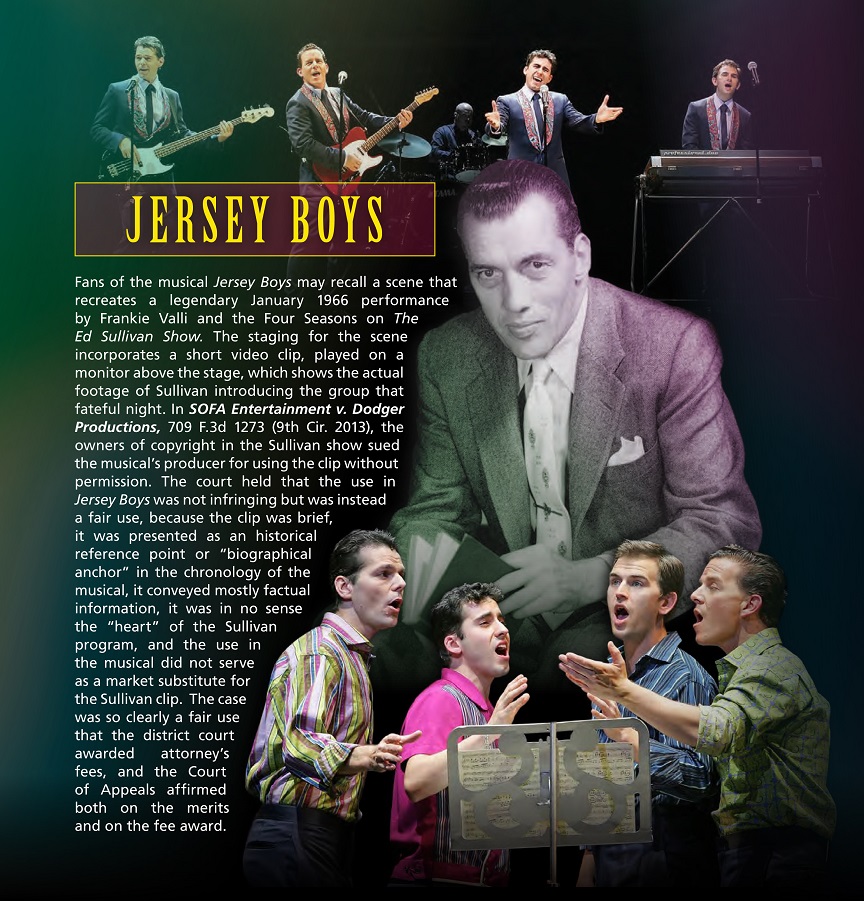
Jersey Boys
Fans of the musical Jersey Boys may recall a scene that recreates a legendary January 1966 performance by Frankie Valli and the Four Seasons on The Ed Sullivan Show. The staging for the scene incorporates a short video clip, played on a monitor above the stage, which shows the actual footage of Sullivan introducing the group that fateful night. In Sofa Entertainment v. Dodger Productions, 709 F.3d 1273 (9th Cir. 2013), the owners of copyright in the Sullivan show sued the musical’s producer for using the clip without permission. The court held that the use in Jersey Boys was not infringing but was instead a fair use, because the clip was brief, it was presented as an historical reference point or “biographical anchor” in the chronology of the musical, it conveyed mostly factual information, it was in no sense the “heart” of the Sullivan program, and the use in the musical did not serve as a market substitute for the Sullivan clip. The case was so clearly a fair use that the district court awarded attorney’s fees, and the Court of Appeals affirmed both on the merits and on the fee award.
Images:
The cast of Jersey Boys performs in 2006, photographed by Sara Krulwich for the New York Times. Copyright Sara Krulwich/The New York Times
Actors J. Robert Spencer, John Lloyd Young, Daniel Reichard, and Christian Hoff in Jersey Boys, photographed by Sara Krulwich for the New York Times, 2005. Copyright Sara Krulwich/The New York Times
Ed Sullivan in a 1955 publicity photograph; photograph and copyright by Maurice Carnes LaClaire, JU8317 U.S. Copyright Office, no renewal found. Library of Congress, Prints & Photographs Division, LC-USZ62-123391
November 2018
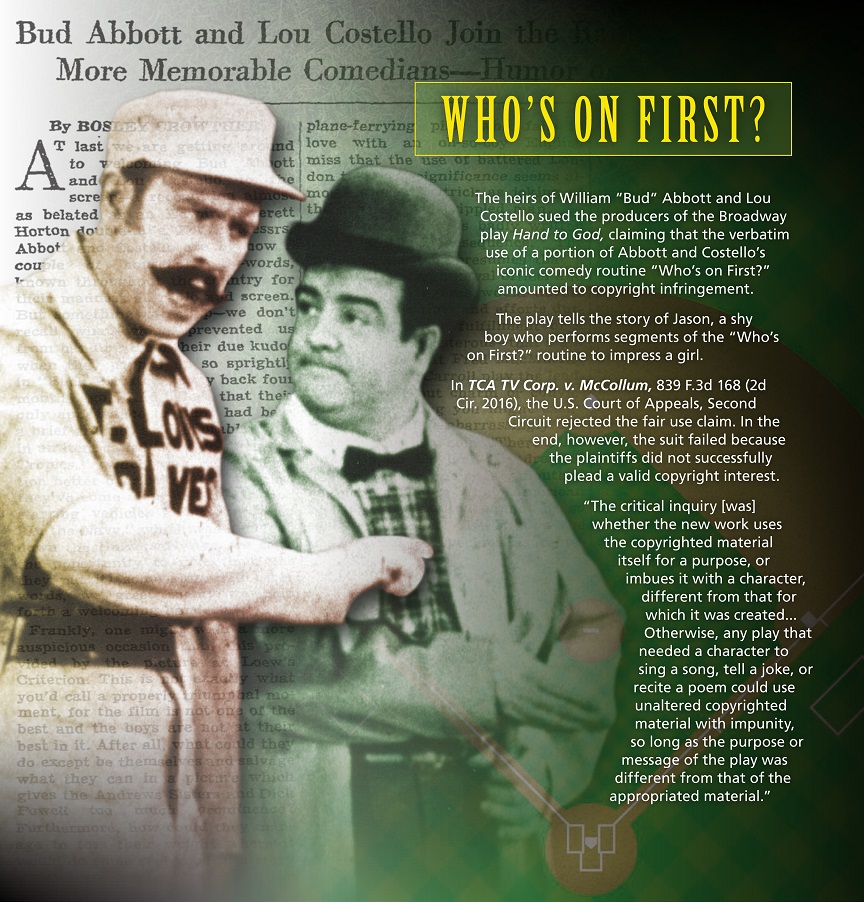
Who’s on First?
The heirs of William “Bud” Abbott and Lou Costello sued the producers of the Broadway play Hand to God, claiming that the verbatim use of a portion of Abbott and Costello’s iconic comedy routine “Who’s on First?” amounted to copyright infringement.
The play tells the story of Jason, a shy boy who performs segments of the “Who’s on First?” routine to impress a girl.
In TCA TV Corp. v. McCollum, 839 F.3d 168 (2d Cir. 2016), the U.S. Court of Appeals, Second Circuit rejected the fair use claim. In the end, however, the suit failed because the plaintiffs did not successfully plead a valid copyright interest.
“The critical inquiry [was] whether the new work uses the copyrighted material itself for a purpose, or imbues it with a character, different from that for which it was created… Otherwise, any play that needed a character to sing a song, tell a joke, or recite a poem could use unaltered copyrighted material with impunity, so long as the purpose or message of the play was different from that of the appropriated material.”
Images:
Abbott (left) and Costello in a “Who’s on First?” performance still. Courtesy of the Baseball Hall of Fame, BL-3330.85
The New York Times, June 15, 1941. Copyright the New York Times
December 2018
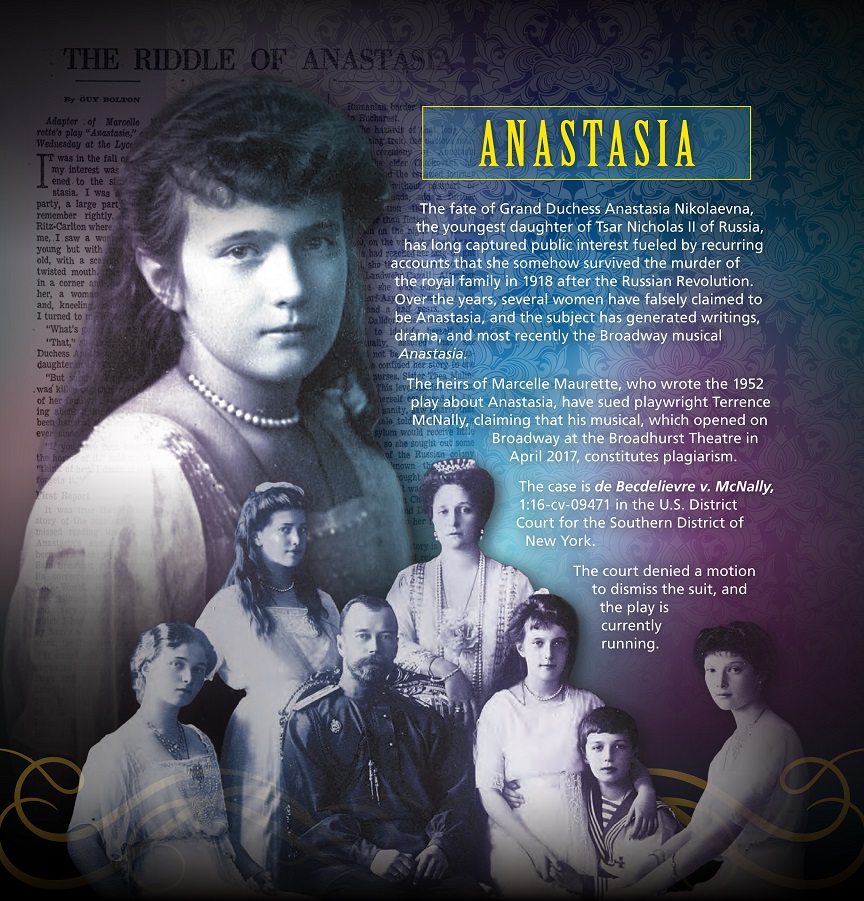
Anastasia
The fate of Grand Duchess Anastasia Nikolaevna, the youngest daughter of Tsar Nicholas II of Russia, has long captured public interest fueled by recurring accounts that she somehow survived the murder of the royal family in 1918 after the Russian Revolution. Over the years, several women have falsely claimed to be Anastasia, and the subject has generated writings, drama, and most recently the Broadway musical Anastasia.
The heirs of Marcelle Maurette, who wrote the 1952 play about Anastasia, have sued playwright Terrence McNally, claiming that his musical, which opened on Broadway at the Broadhurst Theatre in April 2017, constitutes plagiarism.
The case is de Becdelievre v. McNally 1:16-cv-09471 in the U.S. District Court for the Southern District of New York.
The court denied a motion to dismiss the suit, and the play is currently running.
Images:
The New York Times, December 26, 1954. Copyright The New York Times
Portrait of Grand Duchess Anastasia Nikolaevna of Russia. Library of Congress, Prints & Photographs Division, LC-DIG-ggbain-38336
Portrait of the Russian royal family, 1914. Anastasia is pictured seated and holding her brother, the Czarevitch Alexis. Library of Congress, Prints & Photographs Division, LC-DIG-hec-04746

